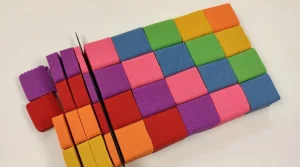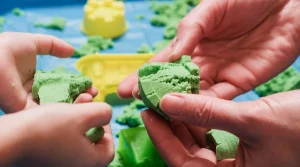
What Is Sensory Sand Made Of? The Science and Benefits
Explore what sensory sand is made of, why children love it, and how its unique materials enhance learning, creativity, and fine motor skills.
#1 Toys Manufacturer in China. WhatsApp: +86 180-0088-4063. Email: [email protected]
#1 Toys Manufacturer in China. WhatsApp: +86 180-0088-4063. Email: [email protected]

Magic sand has become one of the most talked-about sensory toys in classrooms and homes. It looks like ordinary sand but sticks together in curious ways, making it easy to mold. Children often find themselves lost in shaping, pressing, and breaking it apart. This kind of play feels both strange and familiar, which explains its strong appeal.
Yet, for parents and teachers, curiosity is not enough. They often ask the same question: is it safe? With any toy that involves touch, and sometimes accidental taste, safety must come first.
At first glance, magic sand looks like the stuff you’d scoop up at the beach. But when water touches it, the story changes—it stays dry and keeps its shape. That unusual reaction sparks both curiosity and caution. To understand its safety, it helps to know the science and how it compares to other sands.
Magic sand is made by coating regular grains with a thin layer of a water-repelling substance, often silicone-based. This coating makes the sand hydrophobic, meaning it resists water. Instead of soaking, it clumps together.
In practice, this means the grains don’t spread out in water, but form shapes and layers. To a child, it looks almost alive, sliding smoothly but never turning muddy. Scientists use the same principle in waterproof fabrics and non-stick surfaces.
Still, the coating is what raises questions. While silicone is widely used in food and medical products, not every formula of magic sand is the same. That’s why safety testing is critical before children handle it.
Magic sand is often confused with kinetic sand. Both mold easily, but they are not the same. Kinetic sand mixes regular sand with a binding polymer, giving it a dough-like feel that holds shapes even outside of water.
Magic sand, on the other hand, only shows its special properties when water is present. It repels liquid, staying dry no matter how long it’s submerged. Regular sand, by contrast, absorbs water and packs down naturally—think sandcastles at the beach.
For children, the play experience feels different. Magic sand is more about surprise and science, while kinetic sand leans toward creative building. Regular sand is simple, but harder to keep clean indoors. Each type brings its own safety concerns, which is why comparisons matter.
Parents and teachers often ask one big question before bringing magic sand into playrooms: is it safe? The answer depends on testing, certification, and how the toy is used. While most versions sold for kids go through strict checks, safety isn’t one-size-fits-all. Age and supervision still matter.
Before magic sand is sold as a toy, it usually has to pass safety standards. These include checks for toxic chemicals, choking hazards, and skin reactions. In the U.S., ASTM F963 is a common standard, while Europe uses EN71. If a product meets these, it shows that the materials have been tested for use by children.
But not every bag of sand is equal. Some products made for science demos or aquarium displays may not be certified for play. That’s why it’s important to look for packaging that clearly states it has passed child-safety testing. Without that mark, the risk of unknown chemicals or coatings is higher.
Age labels on toys aren’t just suggestions; they are based on research about child behavior. For example, children under 3 often explore by putting objects in their mouths, which makes small grains of sand a choking or ingestion hazard.
For older kids, the risks shift more toward skin sensitivity or dust inhalation. A 7-year-old may play responsibly with supervision, while a toddler might scatter or swallow pieces. Following the age label helps reduce accidents, since it matches the toy’s design with a child’s developmental stage.
To judge safety, it helps to know what magic sand is actually made of. Its unique texture comes from a mix of base sand and special coatings. While most child-friendly products avoid harmful chemicals, not every version on the market is designed for play.
>> The Amazing Science of Kinetic Sand: 7 Fascinating Facts
The main ingredient is usually fine silica sand, which is the same mineral found in beach sand. To give it the water-repelling effect, manufacturers often add a coating made from silicone or similar polymers. These coatings stop the grains from clumping when dry, yet allow them to flow smoothly.
Some play versions may also include food-safe coloring agents to make the sand bright and fun. In certified products, these dyes are tested for non-toxicity and designed not to leach out during handling. This reduces the chance of skin stains or chemical exposure during play.
The coatings themselves are not usually dangerous when handled as intended. However, risks can appear if the sand is very dusty. Fine silica dust, for example, has been linked to lung issues when inhaled over long periods (NIOSH, 2002). High-quality magic sand limits loose dust to reduce this concern.
Another hidden risk is with unregulated or novelty versions that use industrial coatings. These may include chemicals not tested for child contact. While they may look similar, they aren’t designed with safety in mind. This is why checking for toy-safety certification is more reliable than guessing based on appearance.
Magic sand is not just about fun; it also connects to how children grow and learn. From a developmental view, it supports both physical and mental skills. Teachers and parents often notice that kids can focus longer during sand play, which makes it a useful tool in early education settings.
The unusual texture of magic sand draws children to touch, squeeze, and shape it. This hands-on activity stimulates the sense of touch in ways that regular toys cannot. By exploring soft resistance and flow, kids begin to understand texture, weight, and movement.
At the same time, small actions like pinching, scooping, or pressing tools into the sand help refine fine motor skills. These skills are essential for tasks such as handwriting, tying shoelaces, or buttoning clothes. Over time, such practice improves hand-eye coordination in a playful way.
Because the sand can hold form and then collapse back into grains, it invites endless trial and error. Children often test ideas, like how tall a tower can stand before falling. This builds simple problem-solving habits without formal instruction.
In group play, magic sand also becomes a medium for shared storytelling. Kids may work together to build castles, roads, or imaginary lands. These shared projects foster communication and cooperation, turning solo play into an early lesson in teamwork.
Even with many benefits, magic sand still raises questions about safety. Parents and educators want to know if it poses any real danger during daily use. Risks usually depend on how the sand is handled and the age of the child.
Younger children may be tempted to taste or swallow the sand. While small amounts are usually not toxic, ingestion can upset the stomach or pose a choking risk. Pediatric groups often caution against use for kids under three years old for this reason.
Dust is another factor. Some forms of magic sand can release fine particles, especially after heavy use. These particles may irritate sensitive lungs or eyes. Proper ventilation during play can help reduce this concern, particularly in classrooms with many children.
Magic sand is designed to resist water, but that does not make it immune to germs. When handled by multiple children, sweat, saliva, or food crumbs can introduce bacteria. Over time, this may lead to hygiene problems if the sand is not replaced or stored well.
Regular cleaning of play surfaces and encouraging children to wash their hands after play helps maintain safe conditions. Some educators recommend rotating or refreshing the sand to avoid long-term buildup of microbes in shared spaces.
>> How Does Magic Sand Stay Dry? The Fascinating Science Behind
Not every child can handle magic sand in the same way. Age and maturity play a large role in safe use. These guidelines help parents and teachers set limits while still letting kids enjoy the sensory experience.
For toddlers, curiosity often comes through the mouth. Magic sand may look like food and lead to accidental ingestion. Because of this, most safety labels warn against use under age three. Small grains also create a choking hazard for younger children.
Beyond swallowing risks, toddlers lack the fine motor control needed to manage loose materials. The sand may spill easily, increasing dust exposure. For this stage, alternative sensory toys with larger, non-swallowable parts are usually a safer choice.
At ages four to eight, children gain better hand skills and can follow simple rules. With adult supervision, magic sand becomes a safe and engaging tool. Teachers often use it in small groups to encourage sharing and structured play.
Supervision ensures kids do not throw sand, press it near their faces, or mix it with food. Clear rules—like washing hands afterward and keeping sand on the play tray—help reduce hygiene risks and accidents.
By nine or ten, most children can play with magic sand more independently. They can understand safety instructions and respect limits, making unsupervised play more practical at home.
Even so, guidance remains useful. Parents can remind children about proper storage and cleaning routines. Responsibility at this age also means knowing when to stop play if dust or spills become a problem.
Magic sand is one of many sensory play options for children. Understanding how it compares to playdough, slime, and air-dry clay can help parents and educators choose the right tool for learning and fun.
Playdough is soft, malleable, and safe for most ages. Unlike magic sand, it doesn’t spill easily and rarely produces dust. Playdough encourages shaping, rolling, and pressing, while magic sand provides unique tactile feedback and flowing, flowing movement.
Magic sand can be messier, but it offers a sensory experience closer to natural sand. Both materials support fine motor development, but playdough is often better for younger children due to its lower risk of ingestion or dust inhalation.
Slime has a stretchy, squishy texture, unlike the granular feel of magic sand. It often sticks to hands and surfaces, requiring different clean-up techniques. Magic sand is less sticky but can scatter if spilled.
Both materials engage tactile senses and creativity. Slime can emphasize hand strength and stretching, while magic sand emphasizes scooping, pouring, and forming structures. Supervision is important for both to prevent ingestion.
Air-dry clay is moldable and solidifies over time, allowing kids to create lasting sculptures. Magic sand never hardens, providing a continuous sensory flow that encourages temporary, flexible creations.
Clay can be heavier and requires more hand strength, whereas magic sand is light and easy to manipulate. Both support fine motor skills, but clay is better suited for structured, long-term projects while magic sand is ideal for open-ended, short-term play.
Magic sand can provide hours of fun, but proper hygiene and care are essential to keep it safe for children. Regular cleaning and monitoring help prevent bacterial growth, dust accumulation, and potential contamination.
Always store magic sand in a sealed container when not in use to keep out dust, dirt, and moisture. Encourage children to wash their hands before and after play to minimize the transfer of germs.
Avoid mixing sand with other materials, such as water or food, which can promote bacterial growth. Regularly sift through the sand to remove debris or clumps that could affect safety.
Magic sand should be replaced if it develops an unusual odor, visible mold, or becomes excessively dry or clumpy. Signs of contamination, such as dirt, food particles, or discoloration, indicate it’s no longer safe for play. Replacing the sand ensures children can enjoy a safe and hygienic sensory experience while preventing potential health risks.
Magic sand, like other children’s toys, has environmental and ethical aspects that parents and educators should consider. Choosing sustainable materials helps reduce environmental impact while teaching kids valuable lessons about responsibility and care.
Many modern magic sand products are made from non-toxic, recyclable, or biodegradable components. Selecting toys with safe coatings and minimal chemical additives reduces pollution and ensures safer disposal.
By prioritizing eco-friendly products, adults can model conscious choices that support long-term environmental health.
Sensory play with magic sand provides a natural opportunity to introduce sustainability concepts. Children can learn to clean and reuse sand responsibly, understand the importance of minimizing waste, and respect natural resources. These lessons encourage early environmental awareness while keeping play safe and enjoyable.
Magic sand play is most enjoyable and educational when adults provide guidance. Setting up a safe environment and balancing free play with structured activities helps children explore while minimizing risks.
Choose a flat, stable surface for magic sand play, ideally with a tray or container to contain the sand. Ensure the area is well-lit and free from small objects that could pose choking hazards. Keep wipes or a damp cloth nearby to quickly clean spills, and encourage children to wash hands before and after play.
While unstructured play fosters creativity, guided activities can teach problem-solving and fine motor skills. For example, adults can suggest building shapes, counting grains, or creating patterns. This approach supports learning objectives while keeping the play experience fun and safe.
Sand has been a part of children’s play for centuries. From simple outdoor sand pits to artistic sand drawings, it has long encouraged creativity, sensory exploration, and social interaction. Today, sensory toys like magic sand continue this tradition in more controlled and safe forms.
Historically, children used natural sand for digging, molding, and crafting simple toys. In many cultures, sand served both as a medium for play and as a tool for learning basic concepts like shapes, numbers, and patterns. These activities nurtured tactile skills and imaginative thinking from an early age.
Modern educational approaches have embraced sand as a structured sensory tool. Magic sand, kinetic sand, and other tactile toys are now common in classrooms and therapy settings. These toys help children explore textures, practice coordination, and engage in problem-solving while maintaining hygiene and safety standards.
Magic sand offers children a safe, engaging way to explore textures, develop fine motor skills, and spark creativity. By following age-appropriate guidelines, supervising play, and maintaining hygiene, parents and educators can ensure kids enjoy sensory learning while minimizing risks. Safe use transforms fun into meaningful development.
Magic sand can be used outdoors, but it should be kept away from dirt, water, and small debris to maintain hygiene. Outdoor play requires supervision to prevent ingestion or scattering in areas where younger children may encounter it.
With proper care, magic sand can last for months or even years. It should be stored in airtight containers and kept dry. Exposure to moisture or contaminants can cause clumping or reduce its tactile quality.
Most magic sand is designed to be low-dust, but children with asthma or respiratory sensitivities should use it cautiously. Supervised play in well-ventilated areas minimizes the risk of inhaling fine particles.
Magic sand can be combined with materials like kinetic sand or playdough for creative play, but care should be taken to avoid reactions or clumping. Always supervise mixing and ensure it’s age-appropriate.
After play, magic sand should be sifted to remove debris and stored in a dry, sealed container. Washing with water is not recommended, as it can destroy the coating and affect its unique texture.
More Related...

Explore what sensory sand is made of, why children love it, and how its unique materials enhance learning, creativity, and fine motor skills.

Discover what makes kinetic sand so special — from its unique texture to the fascinating science behind its magical movement.

Kinetic sand toys offer fun and education in one—find out how they support child development, relaxation, and imaginative play.

Curious about magic sand? Explore how it repels water, what it’s made of, and why it’s a hit in science classrooms and homes.

Our team will answer your inquiries within 48 hours.
Copyright © 2025 GuangDong AKIA Technology Co,. Ltd. All Rights Reserved